Creating a Solar, EV and Microgrid-Based Distributed Energy System from the ‘Blank Slate’ Created by the Maui Wildfire
When John Sarter’s home was leveled by the wildfire that ripped through Lahaina, Hawaii, Aug. 8, 2023, he created a plan to rebuild it with a home microgrid comprised of solar, storage and bidirectional electric vehicles (EV) – a plan that he says can be replicated across Maui as it rebuilds its energy system and residents rebuild their homes.
The Lahaina fire was the deadliest U.S. wildfire in more than a century, and the fifth deadliest on record since 1871. With most of the grid destroyed and 100 known casualties, the death toll surpassed that of the Camp Fire in Paradise, California, which killed 85 people in 2018.
A tiny home, solar and a bidirectional EV
Sarter, who is West Coast operations and relationships lead for dcbel, which provides bidirectional chargers, will first purchase a tiny home on wheels that’s equipped with solar and add a larger solar canopy. He plans to buy a used Nissan Leaf, which has bidirectional charging capability built into it, and add the dcbel solar inverter, bidirectional charger and home energy management system to power the house and his construction site, effectively creating a microgrid.
The dcbel devices are certified for grid interoperability, meaning they can export power from EVs to the grid so EV owners can earn income in certain markets, said Sarter. The company’s blackout power kit can power a home for three days or more using the EV's battery.
With the dcbel system, the Nissan Leaf will serve as his “power bank,” he said.
The total cost of Sarter’s project would be $99,800, plus $5,200 for a used Nissan Leaf, he said.
Helping provide affordable housing on Maui
Once his new, permanent home is built, he plans on moving the dcbel home energy station to the main home and getting a smaller dcbel system for the tiny home, which can serve as an accessory dwelling unit. The tiny house could also be moved to another location to provide much needed affordable housing for the community, he said.
“If everyone does this, we can rebuild faster and solve the affordable housing crisis in Maui at the same time,” Sarter said.
Sarter is working separately but in tandem with Jennifer Potter, a former Hawaii Public Utilities Commission commissioner and director of innovation at Strategen. Strategen's focus is on helping clients decarbonize, with Sarter's company dcbel able to provide the technology that can help accomplish this. The pair want to implement this plan across Maui as its grid is being rebuilt.
Potter is seeking $150,000 from the Hawaii Community Foundation and $1 million over five years from the federal Department of Energy’s Energy Transitions Initiative Partnership Project.
Creating a new, innovative energy infrastructure
The grants would help fund the Maui PowerBack project, which is a collaboration of West Maui and Maui residents as well as off-island experts who will look at ways to create a “community-driven” energy infrastructure. The project aims to boost resilience and local generation options, including microgrids and vehicle-to-grid technology, according to a proposal for the Maui PowerBack project.
The project participants would complete a six-month preliminary analysis that includes load and generation data based on different resource options with a focus on renewable energy. The project would also identify funding and financing options, along with regulatory changes that would be needed to implement the community plan. And the project would also take a look at possible job creation and workforce development opportunities, according to the project proposal.
Rebuilding from a blank slate
“The town of Lahaina is sort of a blank slate right now that Hawaiian Electric [HECO] and the community have to rebuild,” said Sarter. “And the important thing is to show them the right way to do it. It will be less expensive in the long run and will provide greater resilience overall for the community.”
Residents who are rebuilding their homes could add solar and a bidirectional EV charger to their mortgages, which would be a small incremental cost that yields resilience for the homes and the overall community, he said.
Solar, storage and bidirectional EVs for every home
Ideally, if the residents support this idea, the new energy system for Maui would be fully distributed, with solar on every roof, storage for every home and connections for bidirectional EVs in every home, Potter said.
The community could also install larger community solar and long-duration energy storage facilities.
The plan wouldn’t necessarily include utility power, Potter said. It could be off grid.
“There could be a private developer who comes in and helps with the development of a microgrid and basically interconnects to the utility as a backup,” said Potter.
Sarter said it’s important to enlist the participation of HECO; the utility could find new business models for supporting the distributed system, possibly as a distributed system operator.
HECO has proposed diesel microgrids
“We still do need the grid and I think that the community should stay connected to the grid and be able to export to the grid and earn revenue,” Sarter said.
Meanwhile, the utility could stop investing so much in power plants.
HECO has suggested that Lahaina’s energy infrastructure could be rebuilt as a microgrid and has applied for funding for diesel generators to power the microgrids, Sarter said.
“It seems crazy, in one of the sunniest places on the planet, to be using polluting and noisy diesel generators. Community solar and storage microgrids would make much more sense and be a far more sustainable solution for the future of Lahaina,” he said.
Creating a plan to submit to the state legislature
After its six-month study, the Maui PowerBack project would provide education and resources to help West Maui residents create a community-centered energy plan for generating, distributing and consuming energy, with an emphasis on supporting underserved communities. The participants would submit their plan to the Hawaii Legislature.
“This would be a direct effort to rally the Lahaina community and, along with it, the rest of the Maui community to do community energy planning,” said Potter. The plan submitted to the legislature would identify options and the regulatory pathways needed to “really lift this development in an innovative way,” Potter said.
While the project could move forward with or without HECO, getting HECO on board may not be difficult, given that it’s facing big challenges.
“HECO really has a problem, a lot of problems to deal with,” Sarter said. “So I think they'll be more willing to work with the people in the communities in order to help develop these kinds of innovative solutions.”
About the Author
Lisa Cohn
Contributing Editor
I focus on the West Coast and Midwest. Email me at [email protected]
I’ve been writing about energy for more than 20 years, and my stories have appeared in EnergyBiz, SNL Financial, Mother Earth News, Natural Home Magazine, Horizon Air Magazine, Oregon Business, Open Spaces, the Portland Tribune, The Oregonian, Renewable Energy World, Windpower Monthly and other publications. I’m also a former stringer for the Platts/McGraw-Hill energy publications. I began my career covering energy and environment for The Cape Cod Times, where Elisa Wood also was a reporter. I’ve received numerous writing awards from national, regional and local organizations, including Pacific Northwest Writers Association, Willamette Writers, Associated Oregon Industries, and the Voice of Youth Advocates. I first became interested in energy as a student at Wesleyan University, Middletown, Connecticut, where I helped design and build a solar house.
Twitter: @LisaECohn
Linkedin: LisaEllenCohn
Facebook: Energy Efficiency Markets


